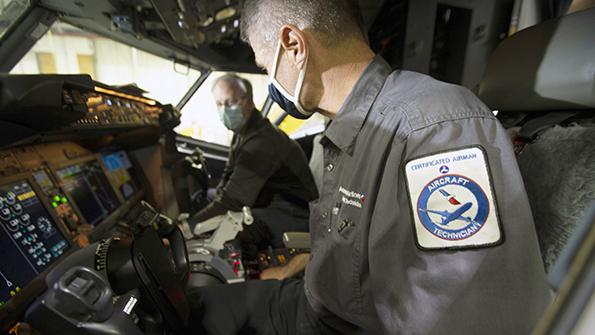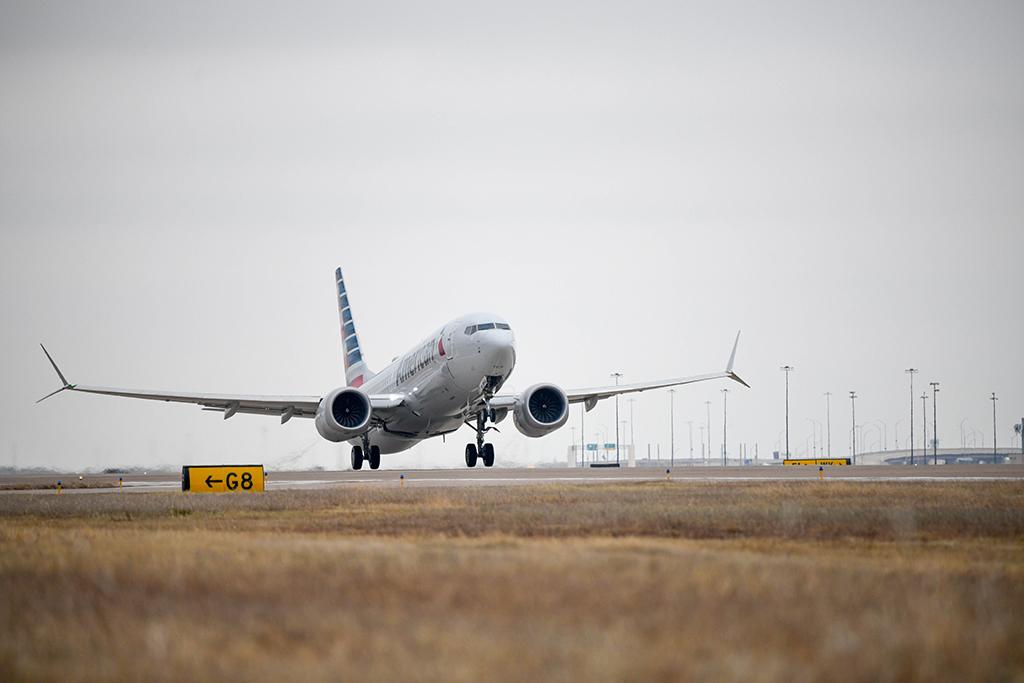
Airlines are steadily adding Boeing 737 MAX-family aircraft to their flight schedules as regulators lift their bans on the model, paving the way for operators to shift focus from reassuring hesitant customers to reaping the benefits of more efficient assets.
As of March 2, 12 carriers were operating 87 737-8s and -9s in revenue service, Boeing figures show. The fleet had logged more than 7,500 revenue flights and 17,500 flight hours.
- 737 MAX grounding ended in December after 21 months
- Boeing 737 MAX operations are ramping up in several global regions
- The active fleet surpassed 100 by mid-March
- China’s timeline remains unclear
By mid-March, the active fleet surpassed 100, and the totals are steadily climbing as more airlines meet regulatory requirements to train pilots, update flight control computer (FCC) software and add aircraft to their schedules. Brazil’s Gol was the first operator to fly paying customers on a MAX following the model’s 21-month grounding, starting flights on Dec. 9. American Airlines was the first North American MAX customer to put the model back in service, on Dec. 29. TUI restarted European operations on Feb. 21.
Notably absent from the operators list so far are airlines based in the Asia-Pacific region. Australia’s Civil Aviation Safety Authority on Feb. 26 became the region’s first regulator to lift its ban on MAX operations. No Australian carriers operate the model, but Fiji Airways and Silk Air flew MAXs to the country before the March 2019 grounding.
While regulators in several jurisdictions, including India and Singapore, have not yet signed off on the 737 MAX’s return, Civil Aviation Administration of China (CAAC) approval remains Boeing’s largest hurdle. Chinese operators had nearly 100 737 MAXs in service when the model was grounded—the most of any country by far. CAAC officials are working with the FAA and Boeing but have not indicated when their ban may be lifted.
“The major safety concerns that were raised by the CAAC have not been fully met, and for this reason, relevant technological review has not entered the certified airworthiness phase,” said Dong Zhiyi, deputy head of the CAAC. The comments were reported in the state-run Global Times.
The CAAC was the first regulator to ground the MAX family following the March 10, 2019, crash of Ethiopian Airlines Flight 302, which came less than five months after that of Lion Air Flight 610. Two fatal 737-8 accidents in short order led to a global grounding and review by regulators. Changes to the model’s FCC software and training were developed and implemented, and regulators—led by the FAA—began lifting their bans in late November (AW&ST Nov. 23-Dec. 6, 2020, p. 16).

Before the COVID-19 pandemic decimated air travel, the MAX’s absence was straining affected operators. The grounding pulled 387 aircraft from the global fleet and halted delivery of 470 more that Boeing built and put into storage.
The drop in demand has meant operators can take a more measured approach to integrating their new Boeing narrowbodies. Despite the shift, operators with MAXs are still eager to get them flying.
“We now have a combination of additional aircraft available to us from the MAX return to service as well as a lower demand environment from this pandemic,” Southwest Airlines Chief Operating Officer Mike Van de Ven said in late January. “That gives our tech ops department several options to optimize our maintenance costs by storing some of our older aircraft—[a mix of 737-700s and -800s]—and replacing any necessary flying with our most efficient aircraft, the MAX.”
Southwest had 34 MAXs in service when the fleet was grounded. It restarted service on March 11 and by year-end expects to have 69 MAXs in its 730-aircraft fleet.
While regulators have included some variances in their mandates, each MAX operator must follow the same basic requirements to get their aircraft ready: Train pilots, update onboard software and put the aircraft through a readiness flight. The mandated changes and training are minimum requirements, however—airlines are free to tailor them to their needs. Several have added to the baseline training developed by Boeing and approved by the FAA.
Alaska Airlines, the first carrier to launch 737 MAX service following the grounding, took delivery of its first 737-9 in January and inaugurated revenue service March 1. Its 737 MAX pilot-training curriculum includes a 4 hr. computer-based course—more than twice as long as the baseline version—and additional scenarios during the mandatory simulator session added to 737 MAX training as part of the changes.
The effort should pay off over time. Alaska calculates its 737-9s will fly about 400 nm miles farther and use 14% less fuel than its comparable 737-900ERs with the same 178-seat configuration.
As airlines ramp up their 737 MAX operations, Boeing is supporting them behind the scenes, offering technical teams and a 24/7 operations center that is slated to remain in place until the entire fleet is back in the air.
The OEM is keeping a low profile during the process, opting to let regulators and operators lead the way publicly. Besides technical support (AW&ST Dec. 21, 2020-Jan. 10, 2021, p. 99), Boeing has offered some promotional material to operators, including videos that explain the steps taken to update the aircraft. Several airlines have put Boeing videos on their own social media channels, integrating them with other information for passengers.
Like the return-to-service technical parameters, most airlines are following the same basic playbook to ease any passenger concerns. For instance, Southwest is allowing customers booked on MAX flights to switch flights free of charge—including fare differences—through the end of May. One exception is tour specialist TUI, which says it cannot guarantee equipment types because of the nature of its operation.
During the grounding, several travel-industry polls suggested that passengers would actively avoid flying on a 737 MAX for at least a while. The coronavirus pandemic changed priorities—most would-be passengers are not flying at all yet. Boeing says load factors aboard 737 MAX flights are “consistent with narrowbody fleet averages.”
Figures vary by region, largely due to travel restrictions that may affect short-haul flying across national borders. Across the board, January’s industry-wide load factor was about 55%, the International Air Transport Association’s latest figures show—an all-time low for the month and a 25-point decline from January 2019.

As 737 MAX operations grow, the FAA is keeping a close eye on the fleet—right down to each flight. The U.S. agency has tapped its wide-ranging flight-data tracking and analysis contract with Aireon to monitor 737 MAX operations as part of the model’s return to service, using a pair of products to get real-time flight alerts.
Under an agreement announced in November, the FAA has access to global air traffic data from Aireon’s space-based automatic dependent surveillance-broadcast (ADS-B) network. The 737 MAX tracking project, revealed publicly during a recent Aviation Week webinar, is among the first specific applications developed under the partnership.
“Aireon’s system will flag deviations from certain parameters during all phases of flight and alert the FAA’s aviation safety division,” the agency explains. “Safety engineers and inspectors will use the early notification to further analyze the incident.”
The project, rolled out in late January, focuses on event detection, including variables such as vertical rates, and specific alerts, such as traffic collision and avoidance system advisories, generated from the flight deck.
“This is allowing them to specifically look at the [International Civil Aviation Organization] codes for just that population of aircraft,” Aireon Chief Technology Officer Vincent Capezzuto said on the webinar.
Aireon is using two products launched last fall to meet the FAA’s needs. The data is delivered via AireonSTREAM, a set of application programming interfaces that can be tailored to pull subsets of data based on specific parameters such as a subfleet or section of airspace, the company said. Alerting and reporting is done through AireonINSIGHTS.
In addition to event-triggered push notifications, the agency can use a situational display to monitor flights in real time, Capezzuto said. Daily reports are also produced that drill down to specific serial numbers.
“The FAA needs to explore the capabilities Aireon is providing,” explains one government official. “The agency figured it might as well use some real-world scenarios as part of the trials. Tracking the MAX fleet fit the bill.”


Comments